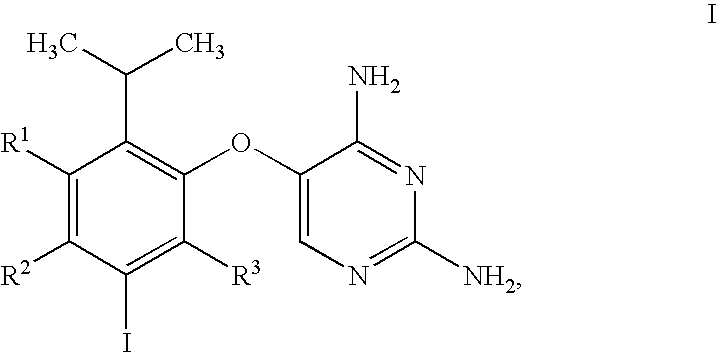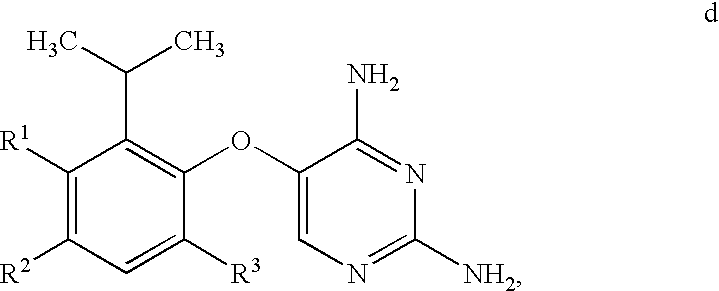Process for synthesis of phenoxy diaminopyrimidine derivatives
a technology of phenoxy diaminopyrimidine and pyrimidine, which is applied in the field of synthesis of phenoxy diaminopyrimidine derivatives, can solve the problems of intense pain and pronounced increase of sensory nerve discharg
- Summary
- Abstract
- Description
- Claims
- Application Information
AI Technical Summary
Benefits of technology
Problems solved by technology
Method used
Image
Examples
example 1
5-(5-Iodo-2-isopropyl-4-methoxy-phenoxy)-pyrimidine-2,4-diamine
[0295]The synthetic procedure used in this Example is outlined in Scheme D.
[0296]
[0297]
[0298]To a cooled solution of 1-(2-hydroxy-5-methoxy-phenyl)-ethanone (10.0 kg) in 79.0 kg of THF was gradually added 46.4 kg of 3M solution of MeMgCl in THF at a rate such that the reaction mixture temperature did not exceed 25 degrees C. Following addition of the MeMgCl solution, the reaction mixture was stirred at ambient temperature for 18 hours, at which point HPLC analysis showed more than 98% conversion of 1-(2-hydroxy-5-methoxy-phenyl)-ethanone to 2-(1-hydroxy-1-methyl-ethyl)-4-methoxy-phenol (not shown in Scheme D). To the stirred solution was then added 10% palladium on carbon (1.02 kg, 50% water wet) suspended in 3.5 Kg of THF. The reaction mixture was cooled and placed under a hydrogen atmosphere at 5 psig, and concentrated HCl (19.5 kg) was added while maintaining the reaction temperature at 25° C. The resultant mixture wa...
example 2
5-(5-Iodo-2-isopropyl-4-methoxy-phenoxy)-pyrimidine-2,4-diamine
[0309]The synthetic procedure used in this Example is outlined in Scheme D.
[0310]
[0311]
[0312]To a cooled solution of 1-(2-Hydroxy-5-methoxy-phenyl)-ethanone (10.0 kg) in 79.0 kg of THF was gradually added 46.4 kg of 3M MeMgCl in THF at a rate such that the reaction mixture temperature did not exceed 25 degrees C. The resultant mixture was stirred at ambient temperature overnight, at which point HPLC analysis showed >98% conversion of 1-(2-Hydroxy-5-methoxy-phenyl)-ethanone to 2-(1-hydroxy-1-methyl-ethyl)-4-methoxy-phenol (not shown in Scheme E). To the stirred solution was added 1.02 kg of 10% palladium on carbon (50% water wet) suspended in 3.5 kg of THF, and the resultant mixture was placed under a hydrogen atmosphere at 5 psig. To the cooled mixture was gradually added concentrated HCl (19.5 kg) at a rate such that the reaction temperature did not exceed 25 degrees C. The resultant mixture was stirred at ambient tempe...
example 3
P2X3 / P2X2 / 3 FLIPR (Fluorometric Imaging Plate Reader) Assay
[0327]CHO-K1 cells were transfected with cloned rat P2X3 or human P2X2 / 3 receptor subunits and passaged in flasks. 18-24 hours before the FLIPR experiment, cells were released from their flasks, centrifuged, and resuspended in nutrient medium at 2.5×105 cells / ml. The cells were aliquoted into black-walled 96-well plates at a density of 50,000 cells / well and incubated overnight in 5% CO2 at 37° C. On the day of the experiment, cells were washed in FLIPR buffer (calcium- and magnesium-free Hank's balanced salt solution, 10 mM HEPES, 2 mM CaCl2, 2.5 mM probenecid; FB). Each well received 100 μl FB and 100 μl of the fluorescent dye Fluo-3 AM [2 μM final conc.]. After a 1 hour dye loading incubation at 37° C., the cells were washed 4 times with FB, and a final 75 μl / well FB was left in each well.
[0328]Test compounds (dissolved in DMSO at 10 mM and serially diluted with FB) or vehicle were added to each well (25 μl of a 4× solutio...
PUM
| Property | Measurement | Unit |
|---|---|---|
| temperature | aaaaa | aaaaa |
| by weight | aaaaa | aaaaa |
| weight | aaaaa | aaaaa |
Abstract
Description
Claims
Application Information
 Login to View More
Login to View More - R&D
- Intellectual Property
- Life Sciences
- Materials
- Tech Scout
- Unparalleled Data Quality
- Higher Quality Content
- 60% Fewer Hallucinations
Browse by: Latest US Patents, China's latest patents, Technical Efficacy Thesaurus, Application Domain, Technology Topic, Popular Technical Reports.
© 2025 PatSnap. All rights reserved.Legal|Privacy policy|Modern Slavery Act Transparency Statement|Sitemap|About US| Contact US: help@patsnap.com



